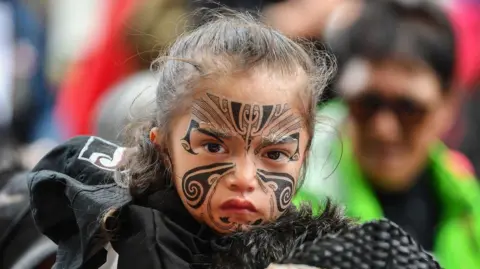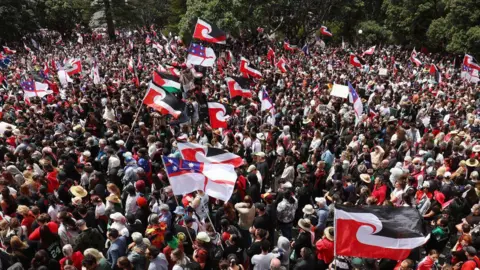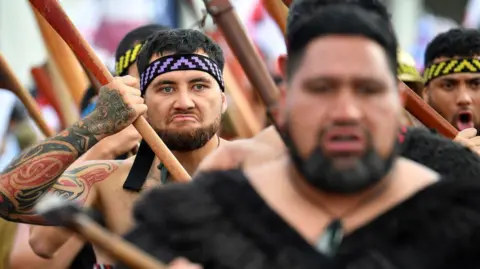The Maori protested as the hikoi arrived in Wellington

 Getty Images
Getty ImagesMore than 40,000 people protested outside New Zealand’s parliament against a proposed bill that seeks to redefine the charter between British colonialists and the Māori people.
Tuesday’s protest marked the end of a nine-day hīkoi, or peaceful demonstration, that has swept across the country.
The hīkoi grew to become the largest in the country’s history, with many participants decked out in the colors of the Māori flag, as they marched through the capital Wellington.
It easily dwarfed the 5,000-strong crowd that turned out for land rights in 1975, and doubled the size of another large hīkoi in 2004, which fought for coastal and ocean rights.
Tuesday’s march brought together activists and supporters who opposed the bill, which was introduced by a small coalition member, the Act political party.
The Treaty Principles Bill states that New Zealand must reinterpret and legally interpret the principles of the 1840 Treaty of Waitangi, a document that appears to be fundamental to the country’s race relations.
The leader of this group, David Seymour, says that over time, the core principles of the agreement have led to ethnic division, not unity.
“My Bill of Rights says that I, like everyone else, whether their ancestors arrived here a thousand years ago, like some of my own, or just got off the plane at Auckland International Airport this morning to start their journey as New Zealanders, the same basic rights and dignity, ” Seymour, who is of Māori descent, told the BBC.
“Your starting point is to take someone and ask them where they are from?” What kind of person are you? That was called apartheid. It used to be called apartheid. It used to be called profiling and discrimination. Now you are trying to do your best. I think that is a big mistake.”
The proposed bill was met with strong opposition, leading to the largest marches New Zealand has ever seen.
Wellington’s rail network has seen what could be a very busy morning as hīkoi pour into the capital, according to the city’s transport chairman Thomas Nash.
Māori queen Ngā Wai hono i te pō led the procession through the grounds around the Beehive, New Zealand’s parliament house, as thousands followed behind.
 Getty Images
Getty ImagesMeanwhile, inside the Beehive, MPs discussed the bill.
Among them was Prime Minister Christopher Luxon, who said it would not go through the law – even though he is part of the same coalition as the Law.
“Our position as the National Party has not changed. We will not support this bill after the second reading and therefore it will not become law,” said Luxon, according to the New Zealand Herald.
“We do not think that with a pen you will rewrite 184 years of debate and discussion.”
New Zealand is often regarded as a world leader when it comes to supporting indigenous rights – but under Luxon’s central government, there are fears those rights are at risk.
“They are trying to take away our rights,” Stan Lingman, who has Māori and Swedish ancestry told the BBC. “[The hikoi is] to all New Zealanders – white, yellow, pink, blue. We will fight this bill.”
Stan’s wife Pamela said he was marching for his “mokos”, which means grandchildren in the Māori language.
 Getty Images
Getty ImagesSome New Zealanders feel the march has gone too far.
“See [Māori] they seem to want more,” said Barbara Lecomte, who lives in coastal areas north of Wellington. “There is a mixture of different nationalities now. We are all New Zealanders. I think we should work together and have equal rights.”
Equality, however, is still a long way off, according to Debbie Ngarewa-Packer, co-leader of Te Pāti Māori (The Māori Party).
“We cannot live in equality if we have one indigenous people living ‘under’,” he said. What the federal government is doing is “a complete attempt to divide a developing country and it is really embarrassing”.
The New Zealand Parliament was temporarily suspended last week as MPs performed the haka, or traditional dance, in opposition to the bill. Photos of the incident went viral.
“To see you in parliament, in the highest house in Aotearoa, there was a real sense of wonder and I think the disappointment and sadness that in 2024 when we see the politics and extremism of Trump, this is what Māori have to endure,” said Debbie Ngarewa-Packer. “It is humiliating for the government because we [New Zealand] they are often considered to be punching above our weight in all the great things in life.”
Protest organizers on Monday taught participants the words and steps of the rally’s haka, the title of which is Te Tiriti o Waitangi (Treaty of Waitangi). The audience enthusiastically repeated the words written on the large white paper, trying to absorb as many words as possible before the meeting.
“This is not just any ordinary hīkoi – this is everyone’s hīkoi,” said grandmother Rose Raharuhi Spicer, explaining that they had appealed to non-Māori people, Pacific Islanders and the wider New Zealand community to support them.
This was the fourth hīkoi Rose played. He comes from New Zealand’s northernmost settlement, Te Hāpua, above Auckland. It is the same place where the very famous hīkoi started back in 1975, protesting for land rights.
This time, he brought his children and grandchildren.
“This is the legacy of our grandchildren,” he said. “It’s not just one person or one group – change [it] it’s wrong.”
Source link




